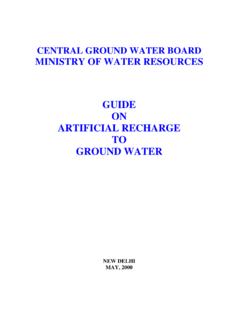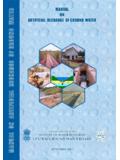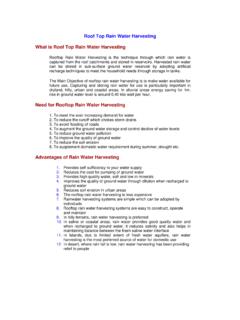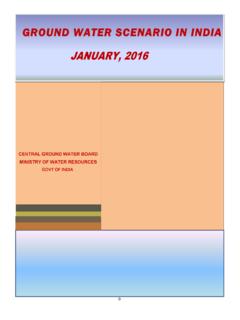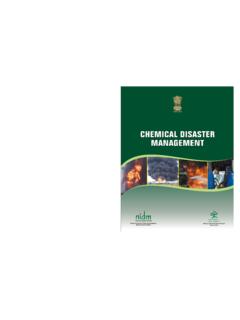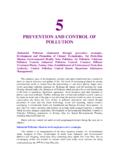Transcription of DISTRICT GROUNDWATER BROCHURE PUDUCHERRY REGION, U. T. OF ...
1 For Official use Technical Report Series SECR/DBR/UT/12-13/01 DISTRICT GROUNDWATER BROCHURE PUDUCHERRY REGION, U. T. OF PUDUCHERRY By DR. D. GNANASUNDAR SCIENTIST C /Government of India /Ministry of Water Resources /Central Ground Water Board /South Eastern Coastal Region /Chennai / December 2013 i DISTRICT AT A GLANCE ( PUDUCHERRY REGION) S. No. ITEMS STATISTICS 1. GENERAL INFORMATION i.
2 Geographical area (Sq. km.) ii. Administrative Divisions (As on 31-3-2013) Number of Communes Number of Villages 5 164 iii. Population (Census, 2011) Total Population Male Female 946600 466143 480457 iv. Average Annual Rainfall (mm) 1383 2. GEOMORPHOLOGY i. Major physiographic Units Coastal plain, Alluvial plain and Uplands ii. Major Drainages Gingee and Ponnaiyar 3. LAND USE (During 2010-11) (Ha.) i. Forest area ii. Net area sown iii. Cultivable waste Nil 11,354 1,646 4.
3 MAJOR SOIL TYPES soil, soil, soil and soil 5. AREA UNDER PRINCIPAL CROPS (During 2010-2011) 1. Paddy -13308Ha (3 crops) 2. Sugarcane 1764 Ha 3. Groundnut 411Ha 4. Casuarina 1227 Ha 6. IRRIGATION BY DIFFERENT SOURCES (During 2010-11) Net Area Irrigated (Ha) i. Dug wells - ii. Tube wells 10000 iii. Tanks - iv. Canals - v. Other Sources - vi. Net Irrigated area 10000 vii. Gross Irrigated area 18699 7. NUMBER OF GROUNDWATER MONITORING WELLS OF CGWB (As on ) ii i. Number of dug wells 4 ii. Number of piezometers 7 8.
4 PREDOMINANT GEOLOGICAL FORMATIONS Recent Alluvium, Sandstones, Clay- stones & Lime-stones of Cretaceous & Tertiary era. 9. HYDROGEOLOGY i. Major water bearing formations (i) Fissured and fractured crystalline formations and (ii) Porous sedimentary formations comprising Cuddalore & Vanur Sandstones. ii. Pre monsoon (May 2012) Depth to water level in Alluvial Aquifer Depth to Piezeometric Surface in Tertiary Aquifer Depth to Piezeometric Surface in Cretaceous Aquifer (mbgl) iii. Post monsoon (January 2013) Depth to water level in Alluvial Aquifer Depth to Piezeometric Surface in Tertiary Aquifer Depth to Piezeometric Surface in Cretaceous Aquifer (mbgl) iv.
5 Long-term water level trend in 10 years (2002- 2012) Alluvial Aquifer Tertiary Aquifer Cretaceous Aquifer Pre monsoon Rise (m/year) Fall (m/year) Min Max Min Max 10. GROUNDWATER EXPLORATION BY CGWB (As on 31-03-2013) i. Number of Exploratory wells ii. Number of Observation wells iii. Number of Piezometers including HP iv. Number of Slim Holes v. Number of Deposit wells 12 8 9 4 14 iv. Depth range(mbgl) - v. Discharge(lps) - vi. Storativity (S) x 10-4 x 10-3 vii. Transmissivity (m2/day) 50 - 2000 11.
6 GROUNDWATER QUALITY (As on May 2012) i. Presence of chemical constituents more than permissible limit Cl, Fe & F ii. Type of water Shallow Aquifer: Ca-Mg-HCO3 Deeper Aquifer : Ca -Mg HO3, Na-Cl 12. DYNAMIC GROUNDWATER RESOURCES (As on ) in MCM i. Annual Replenishable GROUNDWATER Resources ii. Total Annual GROUNDWATER Draft for all purposes iii. Projected demand for Domestic and Industrial Uses up to 2025 iv. Stage of GROUNDWATER Development 139 % iii 13. AWARENESS AND TRAINING ACTIVITY i. Mass Awareness Programs Organized Year 2003-2004 Place PASIC Complex, Thattanchavadi, PUDUCHERRY Number of Participants 250 ii.
7 Water Management Training Organized Year 2003-2004 Place PASIC Complex, Thattanchavadi, PUDUCHERRY Number of Participants 36 III. Awareness through Painting Competition on water conservation /save water for School children(IV VIII std) Year 2011, 2012 & 2013 14. EFFORTS OF ARTIFICIAL RECHARGE & RAINWATER HARVESTING Technical Guidance were provided as when sought i. Projects completed by CGWB Number of structures Amount spent Nil ii. Projects under technical guidance of CGWB Number of structures Nil 15.
8 GROUNDWATER CONTROL AND REGULATION i. Number of OE Blocks 1 ii. Number of Critical Blocks - iii. Number of Commune Notified 1 ( PUDUCHERRY ) 16. MAJOR GROUNDWATER PROBLEMS AND ISSUES i) High GROUNDWATER development in Sandstones. ii) Sea water ingress. iii) Industrial pollution. 1 DISTRICT GROUNDWATER BROCHURE PUDUCHERRY REGION, U. T. OF PUDUCHERRY INTRODUCTION Administrative Details PUDUCHERRY region is situated on the Coromandel coast between 11o 45 and 12o 03 N latitudes and 79o 37 and 79o 53 E longitudes with an area of 293 sq.
9 Km. It is divided into five communes, which comprise 164 inhabited villages. Basin and sub-basin The DISTRICT is part of the composite east flowing river basin. Drainage There are two major rivers draining this region 1) the Gingee river, which traverses the region diagonally from north-west to south-east and 2) the Ponnaiyar (Penniyar) river, which forms the southern border of the region. The river Gingee also known as the Varahanadi or Sankaraparani, which has its source in the hills of Malayanur of Villupuram DISTRICT , Tamil Nadu has a course of 34 km in this region before it confluences with the Bay of Bengal.
10 The river Ponnaiyar originates from the hills of Karnataka and enters the PUDUCHERRY region after flowing through the districts of Dharmapuri, Salem, Vellore and Cuddalore of Tamil Nadu. All the rivers are ephemeral in nature. About 140 small and two big tanks are in the region. These tanks are interlinked and act as water storage for agricultural purposes as well as to recharge the GROUNDWATER . Irrigation Practices The nine-fold lands use classification for the region (2010-11) is given below. Sl. No. Classification Area (Ha) 1 Forests - 2 Barren & Uncultivable Lands 71 3 Land put to non agricultural uses 11,951 4 Cultivable Waste 1,646 5 Permanent Pastures & other grazing lands - 6 Groves not included in the area sown 518 7 Current Fallows 2,602 8 Other Fallow Lands 1,236 9 Net Area sown 11,354 Total 29378 (Source: Directorate of Economics and Statistics, PUDUCHERRY ) 2 The entire irrigation is covered from GROUNDWATER by means of tube wells, which constitute 100 percent of the net area irrigated.

